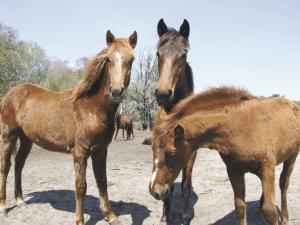Rare Breed Of Horses Saved From Extinction
 ✖  |
There are thought to be less than 200 remaining Marsh Tacky horses worldwide, a breed that was once common in the swampy and marshy regions of S. Carolina and Georgia. But that was nearly 500 years ago, and the Marsh Tacky is now in a race to rebuild its critically endangered numbers.
"Until recently, the breed was thought to have become extinct during the 1980's and 1990's, but it has managed to hold, thanks to a small group of people committed to their long-held family traditions of owning Marsh Tackys," says Jeannette Beranger, a researcher with the American Livestock Breeds Conservancy (ALBC).
This small-stature breed originated from Colonial Spanish bloodlines and ranges in height from 13.5 to 15 hands. They come in a variety of colors and some Marsh Tackys exhibit primitive markings, like dorsal zebra leg stripes, and may be naturally gaited. Manes and tails are usually long, reflecting their Spanish heritage.
According to the Carolina Marsh Tacky Outfitters, operated by David Grant and Phil Hayes of Florence, South Carolina, horses of this breed are usually kind, level-headed and easy keepers.
They're "excellent on trails, sure-footed and swamp-savvy," making them ideal hunting horses.
The breed is generally short coupled and deep bodied, but narrow from the front so that the front legs join the chest in the shape of an "A" rather than the shape of a "U" that's seen in most stock horse breeds. The croup is sloping and the tail is set low.
They have broad foreheads, narrow faces, and straight profiles. They're athletic and useful for a variety of riding disciplines such as ranch work, endurance competitions, and pleasure riding. They have an unusually long stride.
According to Grant, "throughout the 1800's, Tackys were reported to have been found as far north as Myrtle Beach and as far south as Georgia down to St. Simons, almost to the Florida border."
The breed was first documented in South Carolina in 1526, according to Beranger. "Modern history indicates the horses still roamed freely by the hundreds in the early 20th century on the islands off S.C., including Hilton Head. Native islanders continued to breed and use the Tackys until the 1950's when developers moved in, paving roads and gobbling up real estate," says Grant.
The newly formed Carolina Marsh Tacky Association consists of owners and breeders who are working together to complete a stud book and manage the population.
Contact: FARM SHOW Followup, Carolina Marsh Tacky Association, Susan Day, secretary, 6685 Quarter Hoss Lane, Hollywood, S.C. 29449 (ph 843 860-5736; susan.a.day@navy.mil) or Carolina Marsh Tacky Outfitters, David Grant and Phil Hayes, 2637 Anderson Farm Rd., Florence, S.C. 29501 (ph 843 662-7806 or 843-332-262, cell 843 858-0181, david grant@bell south.net; www.carolinamarshtacky.com).

Click here to download page story appeared in.
Click here to read entire issue
Rare Breed Of Horses Saved From Extinction LIVESTOCK Horses/Mules 31-6-27 There are thought to be less than 200 remaining Marsh Tacky horses worldwide, a breed that was once common in the swampy and marshy regions of S. Carolina and Georgia. But that was nearly 500 years ago, and the Marsh Tacky is now in a race to rebuild its critically endangered numbers.
"Until recently, the breed was thought to have become extinct during the 1980's and 1990's, but it has managed to hold, thanks to a small group of people committed to their long-held family traditions of owning Marsh Tackys," says Jeannette Beranger, a researcher with the American Livestock Breeds Conservancy (ALBC).
This small-stature breed originated from Colonial Spanish bloodlines and ranges in height from 13.5 to 15 hands. They come in a variety of colors and some Marsh Tackys exhibit primitive markings, like dorsal zebra leg stripes, and may be naturally gaited. Manes and tails are usually long, reflecting their Spanish heritage.
According to the Carolina Marsh Tacky Outfitters, operated by David Grant and Phil Hayes of Florence, South Carolina, horses of this breed are usually kind, level-headed and easy keepers.
They're "excellent on trails, sure-footed and swamp-savvy," making them ideal hunting horses.
The breed is generally short coupled and deep bodied, but narrow from the front so that the front legs join the chest in the shape of an "A" rather than the shape of a "U" that's seen in most stock horse breeds. The croup is sloping and the tail is set low.
They have broad foreheads, narrow faces, and straight profiles. They're athletic and useful for a variety of riding disciplines such as ranch work, endurance competitions, and pleasure riding. They have an unusually long stride.
According to Grant, "throughout the 1800's, Tackys were reported to have been found as far north as Myrtle Beach and as far south as Georgia down to St. Simons, almost to the Florida border."
The breed was first documented in South Carolina in 1526, according to Beranger. "Modern history indicates the horses still roamed freely by the hundreds in the early 20th century on the islands off S.C., including Hilton Head. Native islanders continued to breed and use the Tackys until the 1950's when developers moved in, paving roads and gobbling up real estate," says Grant.
The newly formed Carolina Marsh Tacky Association consists of owners and breeders who are working together to complete a stud book and manage the population.
Contact: FARM SHOW Followup, Carolina Marsh Tacky Association, Susan Day, secretary, 6685 Quarter Hoss Lane, Hollywood, S.C. 29449 (ph 843 860-5736; susan.a.day@navy.mil) or Carolina Marsh Tacky Outfitters, David Grant and Phil Hayes, 2637 Anderson Farm Rd., Florence, S.C. 29501 (ph 843 662-7806 or 843-332-262, cell 843 858-0181, david grant@bell south.net; www.carolinamarshtacky.com).
To read the rest of this story, download this issue below or click
here to register with your account number.







